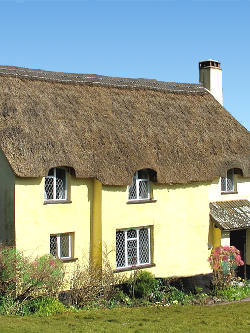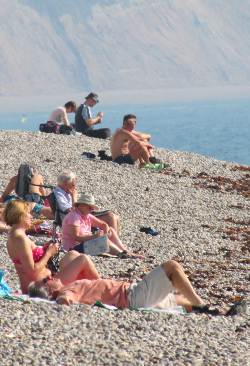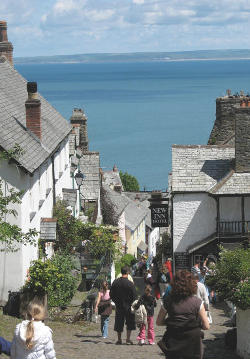

Discover Devon and Cornwall
Tourism and heritage in the Westcountry
About-Britain.com
- a thematic guide to Britain
- Site index
- Essential
information
- Accidents and emergencies
- Pounds and pennies
- Hotel search
- Budget tourism - Britain on the cheap
- Online shopping from the UK
- Driving in Britain
- Low-cost car-hire
- Travel by train in Britain
- Visitor accommodation
- Hotels in London
- Britain's main attractions
- Food and eating in Britain
- Christmas in Britain
- English pubs
- Places
to visit
- Britain's main attractions
- Visiting London
- London for free
- Getting round in London
- Shopping in London
- More great English cities
- Oxford and Cambridge
- Tourism by region
- Discover southeast England
- Discover central southern England
- The West of England - Gloucestershire to Dorset
- The Westcountry - Devon and Cornwall
- Sites & heritage in the East of England
- About Scotland
- Attractions by theme
- Issues & institutions
Tourism
and heritage in the Westcountry - 2
| Index | Devon | Cornwall |
The south coast of Devon is noted for its mild climate, and the south-east facing coast around Torquay and Paignton has become known as the "English Riviera". Beyond Start Point, the southern tip of Devon, the coast is rockier and characterised by many inlets and small estuaries, very popular with yachtsmen. The north coast of this region is famed for its long sandy beaches and rocky coasts. Facing out to the North Atlantic, this coastline is popular with surfers. The area also attracts walkers and hikers, who can follow England's longest hiking trail, the Southwest Coast path. Running from Minehead in west Somerset to Poole in Dorset, this 630 mile hiking trail – over 1000 km – follows this most dramatic of English coasts, round Land's End and the Lizard point, respectively the most westerly and most southerly points in England.
A selection of the best places to see and visit in Devon
| Name | Location | Highlights |
| Seaside resorts, towns and villages | ||
| Seaside resorts | North Devon | On account of the rocky coastline, there are few large resorts on the north Devon coast. The most popular, with their fine beaches, are Ilfracombe and Westward Ho! Other seaside towns or villages are relatively small; these include Clovelly and Lynmouth. |
| Seaside resorts | South Devon | From east to west, favourite seaside resorts include genteel Lyme Regis, Sidmouth and Budleigh Salterton, then the popular resorts of Exemouth, Dawlish, Torquay and Paignton, with their sandy beaches. Beyond Paignton, the coast is mostly rocky and the towns of Dartmouth and Salcombe are popular with yachtsmen. |
| Beer and Lyme Regis | Devon, Jurassic coast |
Two small former fishing ports on the Jurassic coast; Lyme Regis is famous for it "cob", a stone jetty potecting its harbour. Beer, which is smaller, has an attractive beach, and also the Beer caves, former underground stone quarries. |
| Clovelly | Devon North coast |
A classic Devonshire village, beside a steep street (pedestrians only) leading down to a small harbour |
| Widecombe in the Moor | Dartmoor | Classic Devonshire village, located in the Dartmoor national park |
| Dartmouth | South Devon | Home to Britain's Naval Academy, Dartmouth is an attractive small town on the banks of the river Dart, a long sea inlet. The most interesting way to reach Dartmouth is by steam train from Paignton, on the historic Dartmouth Railway. |
| Historic cities | ||
| Exeter | Devon | Exeter is home to one of England's great mediaeval gothic cathedrals, largely dating from the 14th century. Exeter cathedral is remarkable for its long vaulted ceiling, and for its ornate western facade. Exeter's Guildhall is the oldest civic administrative building in England, and has been in use for over 600 years. Other sites: the old port, and the ruins of Rougemont castle. |
| Outdoors and countryside | ||
| Jurassic coast | East Devon and Dorset | UNESCO natural world heritage site. The Devon part of this coast includes the cliffs around the small harbour town of Lyme Regis, known worldwide for their fossil beds from the Jurassic period. Also the small resorts of Beer, Seaton and Sidmouth |
| Exmoor National Park | North Devon and Somerset | Almost 700 sq. km, much of it open grazing land for sheep and wild ponies; a landscape of grass bracken or heather-clad hilltops and valleys, Exmoor - most of which lies in Somerset - is wonderful walking country. Devonshire highlights include the coastal villages of Lynmouth and Coombe Martin |
| Dartmoor National Park | South Devon | Over 950 sq. km of open heather-clad moorland in south Devonshire, including the highest point in the south of England, High Wilhays (621 m). Dartmoor is very popular with walkers. Many of its hilltops are marked by "tors", outcrops of weather-worn granite. There are also a number of prehistoric sites on the moor, notably stone circles and the remains of settlements. the moor is well known for its wild ponies, though these are declining in numbers. |
| English Riviera | Devon | Sheltered from the prevailing winds, the southeast facing coast of Devon, round the resorts of Torquay and Paignton, enjoys one of the mildest climates in Britain, and has become known as the English Riviera. Plenty of sandy beaches and tourist accommodation. |
| North coast of Devon | Devon, | From Exmoor to Hartland Point a beautiful coastline marked by its picture-postcard villages such as Clovelly and Lynmouth, its small traditional resorts including Ilfracombe and Westward Ho!, and its miles of unspoilt coastline accessible to walkers and ramblers. Boat trips from Ilfracombe to the bird sanctuary of Lundy Island. |
| Attractions - places to discover | ||
| Kent's Cavern | South Devon, Torquay | An underground cave complex in which were found the oldest certified traces of homo sapiens in northwest Europe. Guided tours |
| Dartmouth Railway | South Devon, Paignton, |
One of the attractions of the English Riviera, a 10 km steam operated heritage railway running from Paignton to KIngswear, at the mouth of the river Dart |
| Morwellham Quay and Mine | South Devon, near Plymouth | Part of the UNESCO world heritage site, the Cornwall and West Devon mining landscape. Open air museum including a late eighteenth-century quay with historic boats, and a copper mine visited on a mine-train |
Best attractions and places to see in Cornwall
Local
accommodation: ► Find places to stay in Cornwall
: Cornwall hotels & b&bs
at best rates on Booking.com
| Name | Location | Highlights |
| Seaside resorts, towns and villages | ||
| Seaside resorts | North Cornwall | The resorts of north Cornwall are famous for their long sandy beaches, and their surf. there are four main resorts, Bude, Newquay, Perranporth, and St Ives |
| Seaside resorts | South Cornwall | This coast is mostly marked by a rocky shoreline, with numerous inlets and small harbours. As regards seaside resorts, with good beaches, there are only three – Penzance, Praa Sands, and Porthleven. Apart from these there are plenty of small beaches and coves, such as Kynance Cove or Gorran. |
| Truro | Central Cornwall | The Cornish capital - the best shopping in Cornwall, but the small city itself is not one of Cornwall's tourist attractions. The cathedral dates from the 19th century. |
| Penzance | West Cornwall | The "end of the line", the most south-westerly town in England. A popular small resort well located for discovering the nearby points of interest, Land's End, the Lizard, Saint Michael's Mount, and others |
| St. Ives | North coast | Famous for its beaches and its colony of artists, St. Ives is home to an outpost of the Tate Gallery. |
| Historic monuments in Cornwall | ||
| Saint Michael's Mount | South Cornwall |
While much smaller than the more famous Mont Saint Michel in Normandy, Saint Michael's Mount is similar - a rocky island just off the seashore, accessible by a causeway at low tide. Less built up than its Norman counterpart, Saint Michael's Mount is an island village crowned by a priory and castle. Legend has it that the Archangel St. Michael appeared here to fishermen in the year 495 AD. |
| St. Mawe's Castle | South Cornwall | The best preserved of the many defensive castles built by King Henry VIII along the south coast of England in the 16th century. St Mawes, and its sister Pendennis Castle, guard the mouth of the river Fal, outside Falmouth. |
| Outdoors and countryside | ||
| North coast of Cornwall | Cornwall | From Exmoor to Land's End, the north coast of the Devon-Cornwall peninsula is spectacularly beautiful. From Hartland Point on, the coast is exposed to the Atlantic, and is popular with surfers. In summer, the many fine sandy beaches, such as Bude or Perranporth, attract plenty of tourists - though there is room for all, and there are plenty of smaller and often empty beaches. Highlights include the picture-postcard village of Clovelly, Tintagel Castle, perched on the edge of the cliffs, and the small port of St. Ives, which now hosts an outpost of London's Tate Gallery. The whole coast can be discovered on foot, along the northern leg of the Southwest Coast footpath. |
| South coast of Cornwall | Cornwall | The south coast of Cornwall - though not far from the north coast - is gentler. It is characterised by a number of estuaries and inlets, with small fishing ports. Among the highlights of this coast are the small towns of Falmouth, Looe and Penzance, as well as the Eden Project, the Gardens of Heligan, (see below) and Saint Michael's Mount (see above). The whole coast can be discovered on foot, along the Southwest Coast footpath . |
| Land's End and the Lizard | Cornwall | At the extreme southwest are two of Britain's most famous points, the Lizard - the southernmost tip of Great Britain - and Land's End, the westernmost tip of England. Neart Land's End is the dramatically sited Minack open-air theatre, overlooking the Atlantic ocean. |
| Attractions - places to discover | ||
| Poldark Mine tours | Southwest Cornwall, near Helston, | The only complete underground Cornish tin mine open to the pubic. The mine was at its peak in the 18th century, at the start of the industrial revolution; shut down in 1780 and rediscovered in the 1970's, the mine at Poldark has much of its original character. |
| The Gardens of Heligan | Cornwall, near St. Austell | The "Lost Gardens of Heligan" are fabulous sub-tropical gardens, located in a very sheltered spot near the south Cornish coast. Exotic plants from much warmer regions all over the world grow here. Part of the National Rhodedendron collection, including bushes planted in the mid 19th century. |
| The Eden Project | Cornwall, near St. Austell | Plant conservatory, most remarkable for its two huge sets of geodisic domes. One of these recreates a Mediterranean biosphere, the other a tropical biosphere. The tropical dome is large enough to include full size tropical trees. The site is located in a very sheltered south-facing former kaolin pit. The Eden Project is designed as an attraction and as an environmental education facility |
Return to Southwest area guide
Copyright : Texts and
photos © About-Britain.com 2009-2024

Devonshire thatched cottage.
Established in
2009 About-Britain.com
is
an independent guide to the UK, free of external advertising. Pages
may contain links to useful external websites, as well as
affiliate links to relevant travel service providers. A small
commission may be earned from purchases made through these
affiliate links.

Lazy
hazy late summer day on a Devon beach

Heather
covered moorlands in the south west of England

St.
Michael's Mount, Cornwall

Clovelly, north Devon, with view over to South Wales. Photo P Watson.
Offers may include free
delivery
Photo top of page: Graham-H
